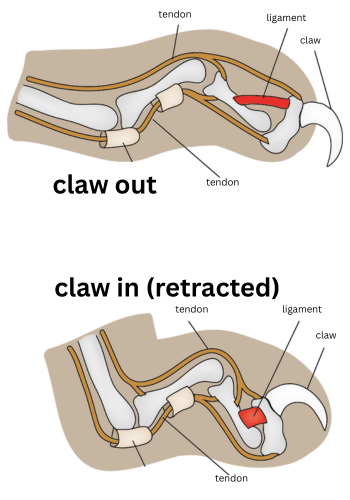Dear Jake,
Sometimes, when I’m working on a tricky question, I scale the tree outside my office. It helps me focus.
I asked my friend Steve Lampa how cats like me do that. He teaches small animal anatomy in the College of Veterinary Medicine at Washington State University.
He told me it’s all about a beefy backside and razor-sharp claws.
“First cats jump and propel themselves with their rump and hind limbs,” Lampa said. “Then they anchor with their claws—which are like grappling hooks. Domestic cats actually have sharper claws than their wild counterparts.”
The jumping part of the climb involves powerful muscles, especially the largest rump muscle called the gluteus medius.
It also relies on strong legs and joints. A cat’s hip joint is a ball-and-socket joint—just like yours. It moves in different directions. Its knee joint, also called the stifle, is a hinge joint—also like yours. It moves back and forth.
But you don’t have sharp, retractable claws on the ends of your fingers.
Neither do dogs. Their claws poke out all the time. That’s why they tippy-tap on the floor when they walk. That scratching and tapping dulls their claws. That’s ok because wild dogs hunt together. Their big weapon is teamwork.
Cats hunt alone. Keeping their claws tucked inside the paw makes them quieter and stealthier. Plus, it protects those claws and keeps them super sharp. When a cat wants to extend its claws, it uses connective tissues—tendons and ligaments—to push them out.

A ligament holds the claw back. When a cat wants to use its claws, it flexes muscles that stretch the ligament. It’s like using your muscles to stretch a rubber band. Image: AI.maier CC 3.0, labels by Dr. Universe
That claw is perfect for sinking into prey—or into a tree as they shimmy up.
Coming down is a lot harder.
“They can’t use their claws going down,” Lampa said. “A lot of times, you see them basically running down so they don’t roll. But they have this ability to right their body, which is a very odd thing.”
A cat climbing down uses its flexible spine and long tail for balance.
And then there’s that righting reflex. It’s why people say a cat always lands on its feet.
A falling cat uses its senses and brain to figure out where it is in space. Then it twists its body. The top half rotates one way, and the bottom half goes the other way—while the cat pulls in its front paws. That makes its head and chest turn faster than its hind end. At just the right time, it stretches out those front paws and tucks the back ones to quickly turn its rump. That’s how a cat sticks the landing.
Physicists call that “reducing the moment of inertia” and “conserving angular momentum.”
Sharp, retractable claws, strong muscles and joints, and flexibility are all adaptations. They help cats climb to survey for food or danger.
I guess being feline has its ups and downs.
Sincerely,
Dr. Universe